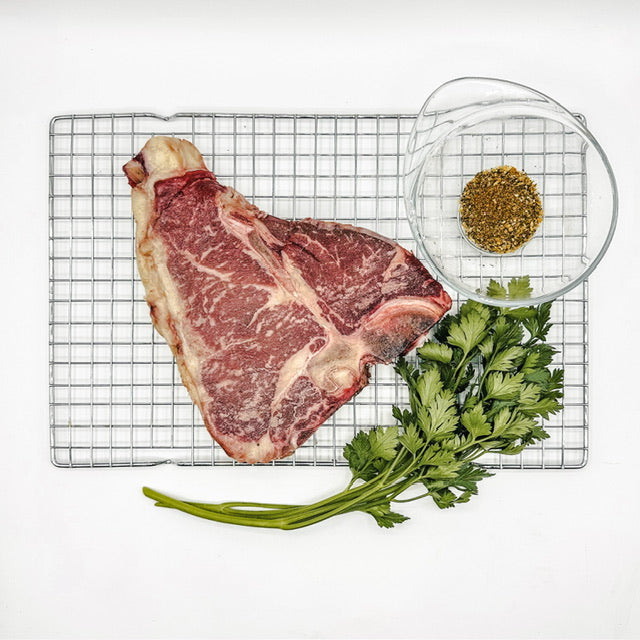
I'm a really big fan of a bone- in steak. Especially the T-Bone Steak!
It holds together well, in the flip-flip-flip on the grill, or even on the sous vide and a quick sear at the end.
In a survey conducted in the past year, 70% of respondents said that steak is their favorite food. It's easy to see why, few foods are more juicy, tender, and delicious. Especially when they're dry-aged steak!
One of the very best cuts on the whole beef is a dry aged T-bone steak. Cooking this large cut can be intimidating, but it doesn't have to be, we're here to help!
Here is your guide to cooking a delicious T-bone steak according to Louisa:
Preparation
Prior to cooking, take the dry aged T-bone steak out of the refrigerator and allow it to reach room temperature for approximately 30 minutes. This step is important and ensures that the steak cooks evenly and achieves the desired doneness.
Use a paper towel to pat the steak dry, removing any excess moisture from the surface. Next, generously season the steak with kosher salt and freshly ground black pepper, adding any additional herbs or spices according to your personal preferences.
Preheating - Grill or Skillet Method
Preheat your grill or skillet to high heat. A hot cooking surface is essential for achieving a proper sear and creating a flavorful crust on the T-bone steak. This step helps lock in the juices and develop a delicious caramelized exterior.
Searing - Don't Skip!
Carefully place the seasoned T-bone steak onto the preheated grill or skillet. If using a skillet, you may need to add a small amount of oil with a high smoke point to prevent sticking. Beef tallow is an excellent choice here!
Allow the steak to sear undisturbed for approximately 3-4 minutes on each side. This initial searing step helps develop a rich brown crust, adding depth and flavor to the steak. For medium-rare doneness, aim for an internal temperature of around 130°F (54°C).
Cooking - Use indirect heat
Once both sides of the T-bone steak have been seared to perfection, you have two options for completing the process of cooking steak. You can choose to continue cooking the steak indirectly on a grill, utilizing lower heat or moving it to a cooler part of the grill.
Alternatively, you can transfer the seared steak to a preheated oven set at approximately 400°F (200°C). The cooking method and time will depend on the thickness of the steak and your desired level of doneness.
Using a meat thermometer, monitor the internal temperature of the steak throughout the cooking process. For a medium-rare T-bone steak, aim for an internal temperature of around 130-135°F (54-57°C) to ensure food safety.
Adjust the cooking time accordingly for different levels of doneness, such as medium or medium-well.
Resting and Serving
Once the T-bone steak has reached the desired level of doneness, remove it from the heat source. Allow the steak to rest for about 5-10 minutes before slicing. This resting period helps the juices redistribute within the meat, resulting in a more tender and flavorful steak.
After resting, carefully slice the T-bone steak against the grain to maximize tenderness. Serve the steak as is, allowing its delicious flavors to shine, or pair it with your preferred accompaniments such as sautéed vegetables, mashed potatoes, or top with a delicious herby chimichurri or compound butter!
Buy Dry Aged T-Bone Steaks Online, Right Here
Cooking this cut of meat doesn't have to be difficult or overwhelming. As you can see, it's just a game of timings and temperatures and you should experiment until you get it the way you like it perfectly done!
If this article has your mouth-watering as it does mine and wanting to get your hands on a dry aged T-bone steak, then we've got you covered.
We've got lots of types of steaks for sale, shop our beef today. We've also got lots of steak recipes to help you cook your steak to perfection.



Leave a comment
Also in Farm Blog
What’s the Difference Between A1 and A2 Milk
Ever wonder if Creamery Creek milk is A1 or A2? The truth is, it’s a natural blend. Our Holstein herd includes both A1A2 and A2A2 cows, and while we track it through genomic testing, we don’t separate the milk. Here’s what that means and why we care about it.
Keep reading
Behind the Scenes: How Your Order Ships from Our Farm
Ever wonder what happens after you click “Place Order”? Take a peek behind the scenes to see how your Creamery Creek box is packed, shipped, and delivered straight from our family farm with care and attention in every step.
Keep reading
What’s Really Going On With Imported Beef
There’s been a lot of talk lately about importing more beef from Argentina to “lower prices.” As a beef and dairy farmer, I wanted to share what that really means from our side of the fence. The truth is, cheaper imports don’t fix the challenges facing American farms, they just make it harder for family operations to survive. Here’s what’s really going on and why local beef still matters.
Keep reading